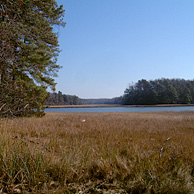| |
 |
 |
 |
| The
marsh along Bland creek just south of Werowocomoco. |
 |

Werowocomoco
at the Time of English Settlement, 1607-1609
The
paucity of historical records concerning the earliest years of English
contact with the Virginia Indians leave historians and archaeologists
with a limited but colorful account of cultural interaction at Werowocomoco.
John Smith's A True Relation describes his December 1607
capture near the headwaters of the Chickahominy River by warriors
loyal to Powhatan's brother, Opechancanough. Smith and his party
were taken to "Waranacomoco upon the River of Pamauncke [York],
where the great king [Powhatan] is resident." During his stay
at Werowocomoco, Smith used the Spaniards as an excuse for the English
presence in Powhatan territory and divulged the need to "revenge"
the death by grisly torture of one of their party by what he supposed
to be members of the neighboring Monacans. Powhatan informed Smith
of the lands and peoples under his control and of his neighbors
and enemies (including the Monacan). Smith describes the "River
of Pamauncke" as "not past twelve miles from that we dwell
on [the James], his course northwest and westerly as the other”
with “Weraocomoco" being "upon salt water in breadth
two miles." This meeting is later elaborated upon in The
General History: The Third Book to include Smith's rescue by
Pocahontas.
Late
in February of 1608, Smith returned to Werowocomoco with Captain
Newport and a group of 30-40 armed men for an official visit to
discuss relations between the two groups. Smith describes the bay
upon which Werowocomoco was sited as having "3 creeks, and
a mile and a half from the channel all ooze," the three creeks
mentioned being in all likelihood present-day Caffee, Leigh, and
Purtan Creeks, and the "ooze" needing no explanation to
anyone who has been up any of them. Smith found himself "mistaken
in the creek, for they all there were within less than a mile,"
a description which closely matches the layout of creeks feeding
into Purtan Bay.
Smith's
later embellishment of his meeting with Powhatan in The General
History: The Third Book includes details of the trade of an
English boy (Thomas Salvage) for a Native American (Namontack),
Powhatan's interest in blue beads, the construction of bridges crossing
the various creeks of the bay, and the population of Werowocomoco
"by two or three hundred savages."
The
Fall of 1608 saw Captain Newport desirous of making Powhatan a vassal
of King James. Newport believed this would ensure the Virginia Indian
leader’s future cooperation. The Captain arrived from Jamestown
"overland to Werawocomoco, some 12 miles.” There he passed
the River of Pamaunkee in a “savage canoe" with four
men to a reception of dancing, the next day intending to "crown"
England's newest ally.
By December of 1608, the English supplies
were running short. Needing to obtain more provisions they approached
Werowocomoco for corn. Their failure to obtain enough food to sustain
the fort at Jamestown convinced John Smith to travel to Werowocomoco.
Powhatan agreed to provide the English with food in exchange for
a grindstone, fifty swords, guns, beads, chickens, and an English-style
house. Four Dutchmen and the Englishman Richard Salvage were sent
to Powhatan to construct his new dwelling at year's end. By mid-January
1609 relations between the two parties had grown increasingly distrustful,
with rampant insinuations regarding the trustworthiness of the Dutchmen.
Some of the English blamed the Dutchmen for inciting the Virginia
Indians against the English. Soon thereafter, Powhatan had removed
himself, his warriors, and all his valuable provisions to the village
of Orapaks on the Chickahominy River.
|



